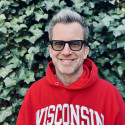Restructured folklore class brings local culture to life
Most students would jump at the chance to customize their own course content for the semester. Robert Howard, an associate professor of communication arts and associate chair of the Folklore Program at the University of Wisconsin–Madison, gave his students such an opportunity.
Howard has taught Folklore 560, Folklore in a Digital Age, before, but with the makeover he gave the course in the spring 2009 semester, it bore little similarity to its roots.
While the old Folklore 560 analyzed e-mail forwards, amateur Web sites and the growing online exchange of rumors and legends, Howard says he wanted to emphasize ethnographic components this time around by having students document real culture around the state.
Last spring’s students of Folklore 560, which was cross-listed with Communication Arts 610, conducted video and audio interviews and gathered images to create digital portfolios to showcase an element of local culture. Each of Howard’s 16 students chose his or her own topic.
The digital portfolios generally consisted of collected footage edited into five- to 20-minute videos.
“The students were supposed to look at their own world, the lives they lead, and ask, ‘Where is everyday performance of identity? Where is everyday communication doing something important and meaningful?'” Howard says.
Students made diverse selections when choosing their projects. Topics included knitting clubs, the Asian American experience and the local culture of railroaders. Several students, Howard says, focused on the culture of college life, a memorable example being the documentation of cheers at UW–Madison hockey games.
Howard says having the students pursue their own topics guarantees a personal investment in the final product.
“One of the reasons I really wanted them to go and pick their own local culture is because I wanted them to think about what culture happens around them and why they value it,” he says.
Communication arts student Emma Vasseur, who graduated this spring, read about the revamped Folklore in a Digital Age Course in a department e-mail.
“This class stuck out because it was something kind of new and different,” she says. “I assumed it was essentially creating a mini documentary, which is kind of what’s happening.”
Vasseur’s project addressed the culture of the uniforms in the Wisconsin roller derby league.
“One of the most fascinating things about [roller derby] is it is a team sport and it is a very serious sport, but the players have the option to express themselves in a way they probably wouldn’t elsewhere,” she says. “In derby you have the option to create an alternate persona and really get into character.”
She says that different teams have different costuming requirements. Some teams allow their girls to wear anything, from corsets to tank tops, as long as they’re all sporting the same colors. Other teams require their players to wear the same shirt, which they can rip, decorate and tie in any fashion they so choose.
“Some of the girls get really into it and create this total opposite person from who they are in real life,” she says. “They think it’s really important and really a big part of the sport.”
On a very different note, curriculum and instruction doctoral student Anne Fraioli, who is also pursuing a minor in folklore, interviewed and taped her friend Lindy Wilson, who creates functional and aesthetic art out of nature.
With branches, twigs and other natural objects she finds in the woods, Wilson makes free-form sculptures, furniture, baskets and dwellings, among other art forms.
Wilson, who sells some of her art at a gallery in Mineral Point, Wis., is part of a larger community of rustic artists and attends the Woodlanders Gathering workshop in Mineral Point every year.
“I feel like I’m contributing to the art world, especially that I get to document the arts and somehow try to make the process of documenting it artistic so it does justice to the art form itself,” Fraioli says.
With a generous grant from George and Pamela Hamel, the Hamel Family Digital Lab was completed with state-of-the-art computers and digital equipment. Students use Final Cut Pro, which is top-end editing software, to create and polish their digital archives.
At first, Howard says, some of his students were intimidated by the equipment, adding that the lab boasts the same video cameras that are used to shoot major motion pictures. “But we’ve really given them a lot of access to the lab and we’ve brought in a lot of experts to help them,” he says.
When the semester came to a close, Howard says his students thoroughly enjoyed the process.
“I’m surprised by how much time they seemed to be pouring into these projects,” he says. “The vast majority of them went way over and beyond the normal amount of time I would expect them to put into a course like this.”
Unlike a lot of final class projects, the folklore class’s digital archives have a shelf life, of, well, possibly eternity.
Currently, Howard is working with colleagues around the country to create ethnographic archives to house cross-searchable folklore content, including student folklore papers dating back to the 1980s, as well as the new digitized archives created by his pilot class.
“Local culture changes so fast,” he says. “If you don’t preserve it, it’s very difficult to see how changes have happened.”
Howard is working with graduate student and project assistant Laura Wynholds from the School of Library and Information Studies. Wynholds assists during class time and shares her expertise on MINDS@UW, an online collection center that stores UW–Madison faculty and staff research, papers, reports and other scholarly output.
Howard and his colleagues created an interface on MINDS that allowed his students to submit their digital archives directly into the database.
While the digital portfolios are currently uploaded into the database, they are not yet publicly accessible. Howard says he is waiting to increase the volume of the archives after he teaches the class again to release them to the public.
Howard, who will be on sabbatical during the fall semester, hopes to gather funds to teach the course again as a larger lecture of 80 or 120 students in spring of 2011, and divide the lecture into smaller sections to be led by teaching assistants in the Hamel Family Digital Lab.



